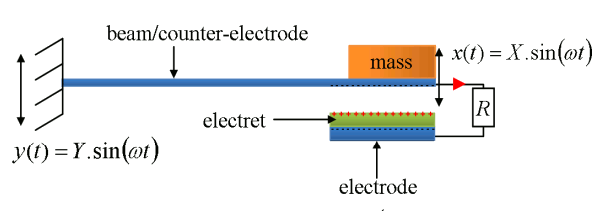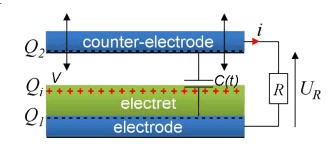
Electret Energy Harvester
December 7, 2011 The first microphone I owned was a "crystal" microphone. This was essentially a thin foil backed with a small patch of Rochelle salt (potassium sodium tartrate, KNaC4H4O6•4H2O). This material is a water-soluble piezoelectric, so it's easy to process to make microphones. It does have the disadvantage that it's fragile, a quality I found after dropping my microphone on the floor. Other inexpensive microphones use magnetism to generate a voltage by moving a coil of wire in a magnetic field by the principle of electromagnetic induction. Sometimes, as in a ribbon microphone, the wire "coil" is just a conductive sheet. The better microphones of yesteryear were condenser microphones in which the vibrating membrane was one plate of a capacitor held at a high voltage. noise present in the biasing supply will be impressed on the microphone signal. These problems are overcome in electret microphones. Electret materials are the electrostatic analog of magnets; that is, they are materials that have a permanent electric field, just as magnets have a permanent magnetic field. Electret microphones use an electret as the non-vibrating plate in a condenser microphone. Microphones are vibration energy-harvesters, since they convert vibration to a voltage signal. Piezoelectricity and electromagnetic induction are commonly applied to vibration energy-harvesting. An electret condenser microphone will also function as a vibration energy-harvester, but a more efficient device would use a cantilever geometry. I described similar cantilever energy-harvesters in a previous article (Cantilever Energy Harvesting, August 16, 2011) That's the device investigated by French scientists from the Laboratoire d'électronique des technologies de l'information (CEA-Leti, Grenoble, France) and Centre national de la recherche scientifique (CNRS).[1-3] The device structure, as shown in the figure, is very similar to that for piezoelectric vibration energy-harvesters, but without the piezoelectric element at the highly-strained portion of the beam near the mounting point. That's replaced by an electret material below the proof mass. A cantilever beam vibration energy-harvester using an electret material. (Via arXiv Preprint Server, Ref. 3, Fig. 1).
The physics involved in such a device can be seen in the figure below. The electret has a constant charge, Qi, and because of charge conservation, this is equal to the sum of charges on the base electrode Q1 and the cantilever electrode Q2. Movement of the cantilever causes a change in the capacitance, which puts a voltage across the load resistance, as described by the following equation:
A cantilever beam vibration energy-harvester using an electret material. (Via arXiv Preprint Server, Ref. 3, Fig. 1).
The physics involved in such a device can be seen in the figure below. The electret has a constant charge, Qi, and because of charge conservation, this is equal to the sum of charges on the base electrode Q1 and the cantilever electrode Q2. Movement of the cantilever causes a change in the capacitance, which puts a voltage across the load resistance, as described by the following equation:
∂V/∂t = Qi / (∂C/∂t)
 | Model of a cantilever beam vibration energy-harvester using an electret material. (Via arXiv Preprint Server, Ref. 3, Fig. 3). |
References:
- S Boisseau, G Despesse, T Ricart, E Defay and A Sylvestre, "Cantilever-based electret energy harvesters," Smart Materials and Structures, vol. 20 no. 10 (October, 2011), Document No. 105013.
- S. Boisseau, G. Despesse, T. Ricart, E. Defay and A. Sylvestre, "Cantilever-based electret energy harvesters," arXiv Preprint Server, November 10, 2011.
- S. Boisseau, G. Despesse and A. Sylvestre, "Electret-based cantilever energy harvester: design and optimization," arXiv Preprint Server, November 10, 2011.
- S. Boisseau, G. Despesse, T. Ricart, E. Defay and A. Sylvestre, "Cantilever-based electret energy harvesters," arXiv Preprint Server, November 10, 2011.
